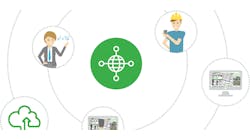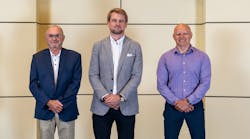Latest from C&E/NetDev Ops/GIS/Open-Source Networks
ISE EXPO 2021 Contractors’ Forum Highlights
At ISE EXPO 2021 in Fort Worth, Texas, I was able to have a LIVE and candid conversation with industry executives from Biarri Networks, Finley Engineering Company, and Wolf Line Construction. We discussed their thoughts related to key issues facing the ICT industry, and specifically their ability to help service providers deliver the necessary broadband networks our communities need.
Face-to-face, we discussed challenges in design and planning, workforce and timelines, funding, technology, and more. I know you’ll find their responses insightful and supportive of what’s needed to prepare our industry for the future.
Happy learning!
Janice Oliva
Publisher, ISE Magazine
Janice Oliva, ISE: What advice do you have for designing and planning fiber networks on tight timelines and even tighter budgets?
Ben Humphrey, VP, Chairman of the Board, Finley Engineering Company:
- Use GIS-based tools and data to prepare high level design and budgets to present to potential funding sources and partners.
- Do not limit yourself to one construction method or technology. Consider alternatives such as aerial plant, ADSS, distributed split, and Fixed Wireless.
- Look for funding/build partners such as state, county, municipals, RECs, and private companies.
- Use industry standard equipment and materials to avoid custom-built, which drives up the cost.
Paul Sulisz, CEO, Biarri Networks: Use technology that has already been proven to help get you through these stages quicker. Since you will need to work with large data sets to get there efficiently and with greater certainty, get the help of people who know how to do this quickly and effectively on your behalf — partner with people who have results.
Work in a way that incentivizes lowest cost, and is predictable. For example, pricing it on a homes-passed method gives better pricing predictability than pricing per foot.
ISE: Do you have a playbook for working with municipalities to improve fiber deployment timelines? If so, share your best practice(s).
Ben Humphrey, Finley Engineering Company:
- Make sure you research the laws concerning municipal-owned communications facilities. Educate the people involved in the project.
- Understand the processes involved with city council meetings, public information requirements, competitive bidding requirements, and processes.
- Have local champions that support the project such as business owners, the medical community, schools and members of the community.
- Be upfront in talking with the Municipality about what you’re doing. Informal introductions and conversations can make it easier for dialogue when problems arise.
Paul Sulisz, Biarri Networks:
- Find a team of vendors who have done it all before, whereby they all bring certain skills and expertise to the table, AND they are doing it for the right reasons.
- Find partners who are willing to transparently collaborate on an approach that allows full transparency throughout the process.
- Maintain standard, open, and interoperable, schemas so you can go fast, AND are ready to accelerate when asked.
ISE: Describe your best experience with a partnership, and why it worked so well.
Ben Humphrey, Finley Engineering Company: One of the best was a partnership with a Rural Electric Cooperative (REC) and private communications company. REC applied for and received CAF II funding to serve 326 customers in NW Minnesota. The co-op would use their own poles and construction crews to install fiber, saving money and time. They would also own and operate the fiber down to the subscriber and the customer premises.
The private communications company would provide re-branded services over the fiber, operate the optical line terminal, provide Triple Play services, and technical support.
The benefits of this kind of partnership are numerous, including more tools and services to better serve their members. The merger of the 2 resources quickly delivered economic development opportunities across northern Minnesota that are life-changing to their residents.
Paul Sulisz, Biarri Networks: We work with a number of great partners. While they have different approaches or business models, we collaborate transparently and partner for success with our clients.
Our best experiences come from programs of work that are based on strong relationships first. These are not transactional deals. We work hard to align to work with people who share our values and are driven by a similar purpose.
ISE: What is your biggest pain point? Share some insights about how you’re overcoming it.
Ben Humphrey, Finley Engineering Company: Like everyone else, our primary pain point is the difficulty in finding, hiring, and maintaining, staff. We are fortunate in that we have multiple locations and can share resources across the company.
We’ve worked to overcome this challenge by cross-training to give our associates a broader experience base. They can then move into various projects and fill gaps as necessary.
We also provide flexibility in work hours, working from home and use of technology.
Finally, we work with local high schools, colleges, and vocational schools, with shadowing and internships. We act as advisors in curriculum development of training programs and classes related to our industry.
Colin Garner, Vice President, Wolf Line Construction: Our primary pain point is poor material management. Supply chain constraints have really elevated this point lately due to a number of factors. If the client isn’t ahead on their materials, their deployment is behind.
We believe early communication about the need for materials is critical. Supporting a client through planning is the best way to overcome this.
Consultant egos can be challenging. We have found some hard-headed consultants who are behind on technology, deployment methodology, and project management. We are in a new, evolving era of broadband. Clients need support for their deployments, but they also need innovation and flexibility.
Paul Sulisz, Biarri Networks: A huge pain point occurs when there is a lack of understanding of what is really needed to get things moving. That means understanding what data is needed, and whether additional information is needed to get the right partners to the table. Insufficiently detailed plans can also hinder getting a jump on key logistical hurdles such as labor and materials – both of which are in high demand.
The best solution is to look to those with a solid track record of doing what they say they were going to do. If you are not sure if they have actually done it, then ask for references!
ISE: Tell us about your top 2 tools in your company’s toolbox. They could be your team, software/hardware, network design tools, etc.
Ben Humphrey, Finley Engineering Company: As a professional services company, our most import asset is our people and the expertise they bring to our customers. We also have trusted partners we collaborate with to provide complete turnkey solutions.
Colin Garner, Wolf Line Construction: We have a great team of engineers who support our deployments by providing work plans, Quality Assurance plans, and tracking tools, for our crews. This group provides reporting, tracking, and documentation, for our clients, which is a great value add; it helps communicate the status of the project, and allows everyone to stay informed on the status of the project.
We also believe our qualified electrical workers who install fiber optic networks safely and efficiently are another great asset. Using a competent, well-trained work force provides a high-quality product for utilities.
Paul Sulisz, Biarri Networks: We believe in a data-driven approach to designing and building networks. Our teams have worked with more data globally than most. And, since we’ve seen most challenges before, these insights and experiences are hard to replicate.
Our platform also enables true geospatial collaboration from start to finish of the build.
ISE: What advice would you give to a contractor just entering into today’s market?
Ben Humphrey, Finley Engineering Company:
- Your reputation is the most important thing you need to maintain. Treat your customers and associates with respect. Remember The Golden Rule.
- Long-term relationship building is key to being successful in this marketspace.
- Provide quality services and/or products, and state what sets you apart from the rest.
- Give back to your community, and help those less fortunate than you.
Colin Garner, Wolf Line Construction: Take care of your workforce. Train and invest in your workforce so they are qualified to deploy networks safely and efficiently; it is the single most important investment you can make.
Paul Sulisz, Biarri Networks: Be careful who you partner with, and maintain very clear, transparent communications with all other contractors and stakeholders.
Paul Sulisz, CEO, Biarri Networks
Paul Sulisz’s career within telecommunications spans 20+ years, involving work in the fiber/fixed access networks, wireless networks including cellular and microwave deployments, and has been actively involved in multiple global deployments. Over the last 6 years, Paul has focused on productizing and deploying innovative approaches to digital design, engineering, and construction, whilst building a global capability for Biarri Networks — all in an effort to help connect the world! Paul is the CEO of Biarri Networks, and resides with his family in Denver, Colorado.
https://biarrinetworks.com
https://www.linkedin.com/company/biarrinetworks
https://www.facebook.com/BiarriNetworks
Ben Humphrey, VP, Chairman of the Board Finley Engineering Company
Ben Humphrey has been with Finley Engineering Company, Inc. since 1977. Ben has a wealth of experience in the broadband field and in numerous leadership positions with Finley. Currently, he serves as Vice President of the Minnesota Division in Slayton, Minn. He was appointed Chairman of the Board of Directors for Finley in 2014. Strategic and visionary, Ben is often called into projects early in the discussion phase as an experienced consultant who knows the questions that need to be addressed. He draws from firsthand experience in the development of strategy and implementation plans. Over the years, Ben has led substantial projects building fiber and broadband networks for our clients. Ben launched the effort that has now become our Business Development Group, and supported the development of our Fixed Wireless Group. As Chairman, Ben works closely with our Board of Directors and Management to set our company’s direction and strategy.
[email protected]
https://www.facebook.com/FinleyEngineeringCompanyInc
https://www.linkedin.com/company/finleyusa
https://vimeo.com/finleyengineering/videos
Colin Garner, Vice President, Wolf Line Construction
Colin Garner is the Vice President of Wolf Line Construction, a construction services company focused on broadband deployments for rural electrical cooperatives. Mr. Garner, a registered professional engineer, received his undergraduate degree in Engineering from the University of British Columbia, and an MBA from the University of South Carolina. He has an extensive background in finance, infrastructure and utility construction, and has worked in North Africa, Canada, Australia, and the United States.

Janice Oliva | VP, Event Business Development, Endeavor Business Media
Janice Oliva is the VP, Event Business Development for Endeavor Business Media. Her primary focus is to develop a comprehensive content strategy for all EBM events that align with the event’s overall goals and objectives and roll out new event launches. Previously, Oliva was VP, Group Publisher Lighting & Digital Infrastructure at EBM and the owner of ISE and ISE EXPO prior to selling to EBM. She has worked with several magazine publishers since 1991 including PCI, Thompson Financial, The Aberdeen Group and Mpls./St Paul Magazine. Oliva has a bachelor’s degree in Communication Studies from the University of Iowa. She resides in St. Petersburg, FL, with her husband and two dogs along with their college age children, Mario and Sydnie, when they come home for rare visits.







